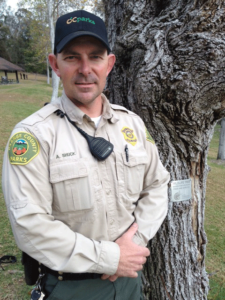Park ranger retains dead trees for urban birds
 Apart from meeting the needs of cyclists, fishermen, runners, birdwatchers, party planners and groups of the elderly and the disabled, Orange County Park Supervising Ranger, Adam Shuck, and staff at the Laguna Niguel Regional Park in southern California, consider their ‘good stewardship’ mandate to protect habitat for birds.
Apart from meeting the needs of cyclists, fishermen, runners, birdwatchers, party planners and groups of the elderly and the disabled, Orange County Park Supervising Ranger, Adam Shuck, and staff at the Laguna Niguel Regional Park in southern California, consider their ‘good stewardship’ mandate to protect habitat for birds.
Trees are high on the list, and they are wanted dead or alive. You see, many birds such as woodpeckers, bluebirds and swallows nest only in the rotting wood of standing trees. This ‘second-life’ value of dead trees includes the insect prey and other functions they provide. That means when dying trees are slated for removal, some get a second look. The question Adam and some rangers are starting to ask is this. Do any of the trees qualify as good bird habitat, are in an appropriate location, and can be made safe for retention? The Cavity Conservation Initiative offers rangers input about the habits and needs of birds. Safety is always a top priority.
When West Coast Arborists, arrived in Laguna Niguel Regional Park this December, six more dead trees were recruited for this purpose, bringing the park’s ‘Wildlife Tree’ inventory to a total of ten. Here are before and after photos of one of them. Contractors shortened the height and limbs of each tree to reduce the risk of tree fall. Signs nailed to the trees explain their purpose. Adam selected ideal locations; along a creek, low down on slopes and away from high-use areas. One dead pine was recruited to serve later generations of nesting birds. (It will likely decay more slowly than others.) You see, different classes of tree decay are an important component of management for wildlife.


Parks are silent ports of entry as well as testing grounds for species displaced by our strong trend toward urbanization and the loss of two million rural acres annually. This makes our green recreational spaces the site of fierce, often unseen competition and selective exclusion. Add this to the conflict. Humans place a high value on picturesque, tidy parks that do not replicate what nature provides in the wild. Naturally, not all species are suited to these conditions. Urban forestry is challenged to adopt practices that accommodate those that have a fighting chance. Think of it this way. Where wildlife survival is concerned, a park ranger’s decisions are no less impactful than those made at airports and international borders by officers of the Immigration and Naturalization Service.
The Cavity Conservation Initiative and the Orange County’s birding community applaud Ranger Shuck and and Orange County Parks for attempting to meet this growing challenge. Consider thanking participating rangers wherever you find them.



Connect
Connect with us on the following social media platforms.